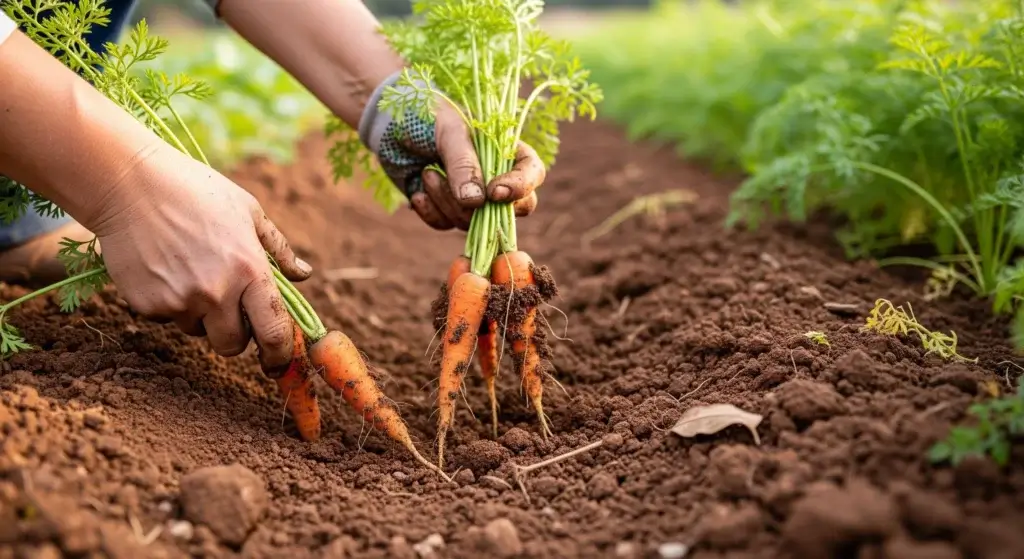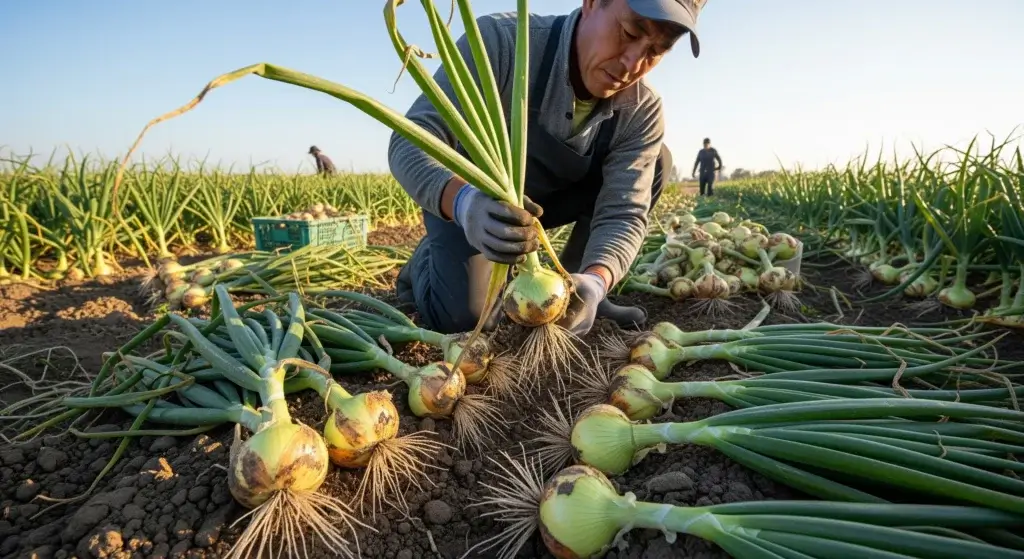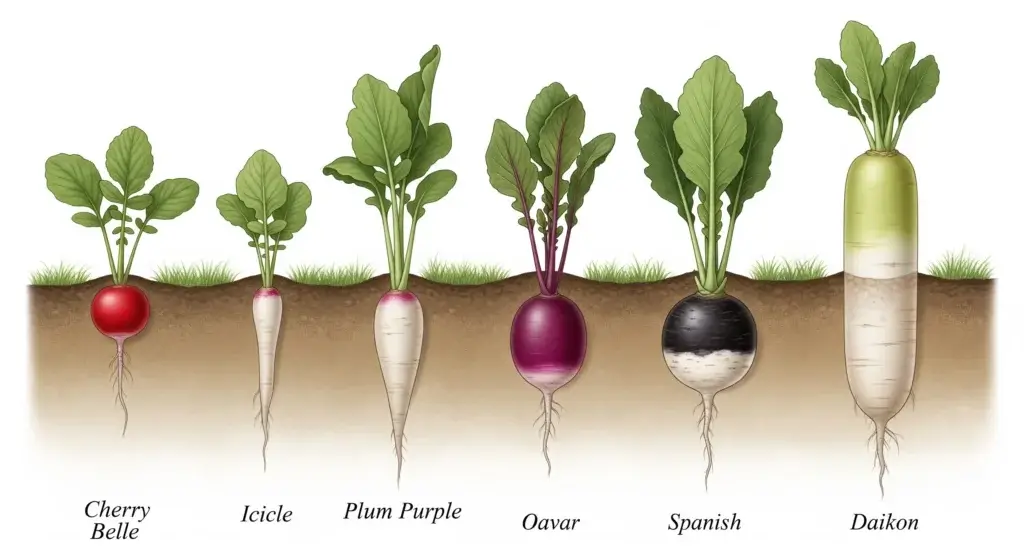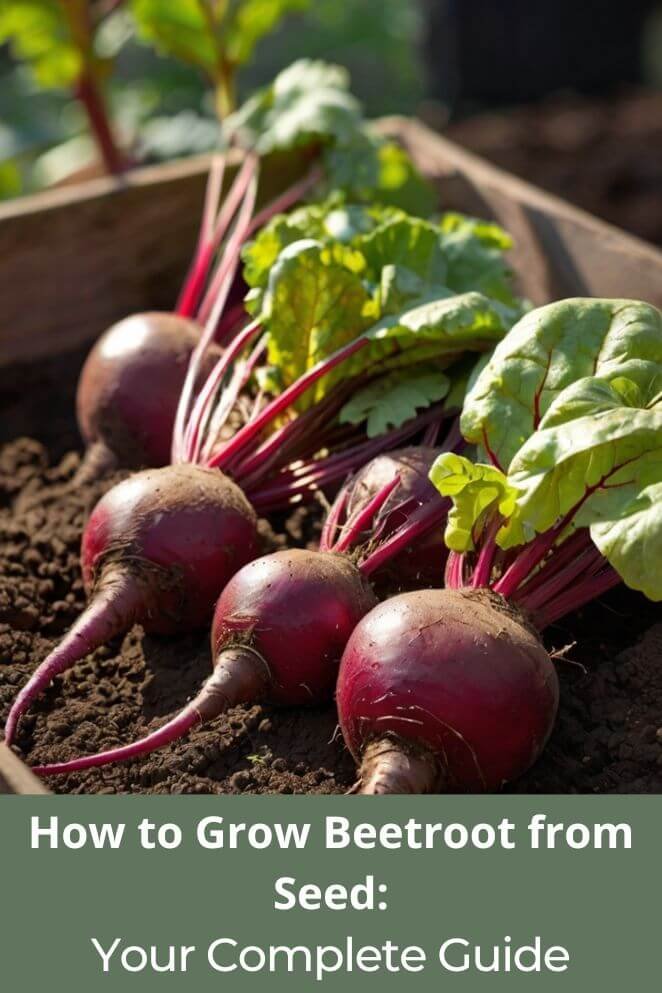
Beets are the underrated superheroes of the garden—easy to grow, crazy nutritious, and they bring serious color to your veggie patch.
Whether you’re just starting out or you’ve got dirt under your nails year-round, growing beetroot from seed is a no-brainer.
This guide gives you the full lowdown—from picking seeds to pulling up your first harvest.
By the end, you’ll know exactly how to grow sweet, earthy beets like a pro (no cape required). Let’s dig in!
Why Choose Beetroot for Your Garden?
If you’re picking veggies for your garden team, beetroot’s the quiet MVP.
It doesn’t complain about cold weather, it grows fast, and you can eat the whole plant—roots and leaves. Total overachiever.
The roots are packed with good stuff like folate, potassium, and natural nitrates (yep, the same kind athletes chug beet juice for).
And those leafy tops? They’re basically salad royalty—loaded with vitamins A, C, and K, and way too underrated.
Beets also play the long game: most types are ready in about two months, and if you store them right, they’ll keep feeding you through winter like a veggie time capsule.
- Read also: Step by Step Guide: How to Plant Eggplant From Seeds
- Read also: Tips and Techniques: A Guide on How to Plant Spinach Seeds
Choosing the Right Beetroot Varieties
Not all beets are created equal—and that’s a good thing.
Choosing the right variety depends on what you want: bold colors, sweet flavor, quick harvests, or just something that won’t bolt in a heatwave.
Here’s a quick breakdown to help you match your beet to your garden goals:
Classic red varieties:
These are your ride-or-die varieties—reliable, flavorful, and perfect for roasting or pickling.
- Detroit dark red – Old-school favorite. Deep red, sweet, and super dependable.
- Chioggia – Looks like a candy cane inside. Great if you want to impress people at salad time.
- Bull’s blood – Grown more for its dramatic red leaves (they’re edible!) than the roots, but you get both.
Alternative color options:
Want beets without the mess—or just something a little different?
- Golden Beet – Mellow and sweet, plus no red-stained cutting boards.
- White Beet – Same great taste, zero color bleed. A minimalist’s dream.
- Cylindra – Long and skinny, like the baguette of beets. Slices like a dream.
Baby beetroot varieties:
Short on space or time? These fast growers are made for containers, raised beds, or impatient gardeners.
- Baby Ball – Round, cute, and ready in a flash. Great for containers.
- Mini Red – Perfect for succession planting. Plant, harvest, repeat.
If you garden in cooler zones, go for bolt-resistant types.
Warmer climate? Look for heat-tolerant varieties so your beets don’t freak out when the sun cranks up.
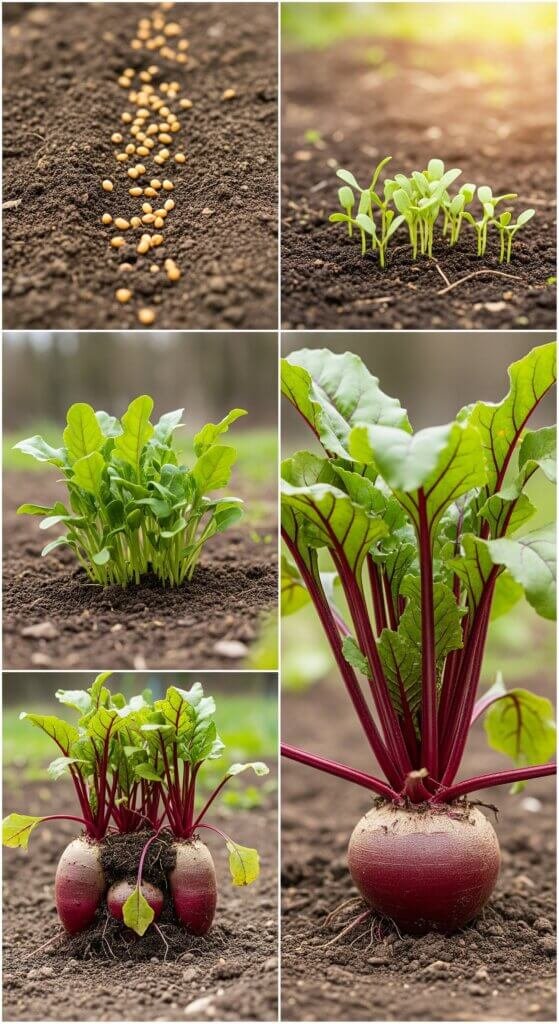
Preparing for Planting: Soil and Site Selection
Before you even think about tossing beet seeds in the ground, you’ve got to prep the stage.
Beets are root veggies, which means the soil really matters—if it’s not right, you’ll get funky, stunted roots (and no one wants sad salad beets).
Soil preparation steps
Beets love loose, well-draining soil with a pH between 6.0 and 7.5.
Translation: Not too acidic, not too packed, and definitely not a swamp.
Quick prep tips:
- Test your pH—use a cheap meter or test kit. It’s like checking the vibe before planting.
- Got clay soil? Break it up with compost, aged manure, or a little coarse sand.
- Sandy soil? Add more organic matter to help it hold water without drying out like a beach towel.
- If drainage is sketchy, build raised beds to keep roots from drowning.
- Clear out rocks, roots, and random junk. Beets need room to grow straight and smooth—no obstacle course, please.
Site considerations
Beets aren’t divas, but they do appreciate a good location—like a well-lit, breezy Airbnb for veggies.
Site Checklist
- At least 6 hours of direct sun a day—more sun = bigger, better roots.
- Some wind protection, but nothing stuffy. Airflow keeps disease in check.
- Easy access to water—because hauling watering cans is a pain.
- Avoid low spots that turn into puddles after rain. Beets don’t swim.
- Space to grow—don’t cram them in like a rush-hour subway.
Step-by-Step Planting Guide
Beets are chill cool-season crops—they like mild weather, not tropical heat or winter drama.
Nailing the timing makes all the difference between a sweet, smooth harvest and a batch of weird, woody roots.
When to plant?
- Spring: Plant 2–4 weeks before your last frost date (yes, before—they’re tougher than they look).
- Summer: Plant 10–12 weeks before your first expected frost.
- Succession: Plant a new row every 2–3 weeks. Boom—succession planting.
Direct seeding process:
Beets like a good setup. Give them space, moisture, and room to stretch out. No crowding, no drama.
Here’s the play-by-play:
- Rake the soil smooth like you’re prepping a fancy garden bed in a British period drama.
- Make shallow furrows—about ½ inch deep.
- Drop seeds 2 inches apart. Give ‘em breathing room.
- Keep rows 12–18 inches apart—you want enough space to weed and water without crawling like a ninja.
- Water gently with a fine spray. Don’t blast them like a fire hose.
- If the temps are dipping below 40°F, toss on a row cover like a cozy blanket.
- Label your rows—because trust me, 3 weeks from now, all seedlings look suspiciously the same.
Container growing options:
Got a balcony, porch, or sunny fire escape? Beets grow great in pots. Just use the right setup.
Container beet basics:
- Use a pot that’s at least 8 inches deep (roots need legroom).
- Good drainage is a must—no soggy bottoms.
- Use quality potting mix—not garden soil.
- Plant seeds 1 inch apart for baby beets, or give more room if you want full-size roots.
- Water more often—containers dry out faster than garden beds.
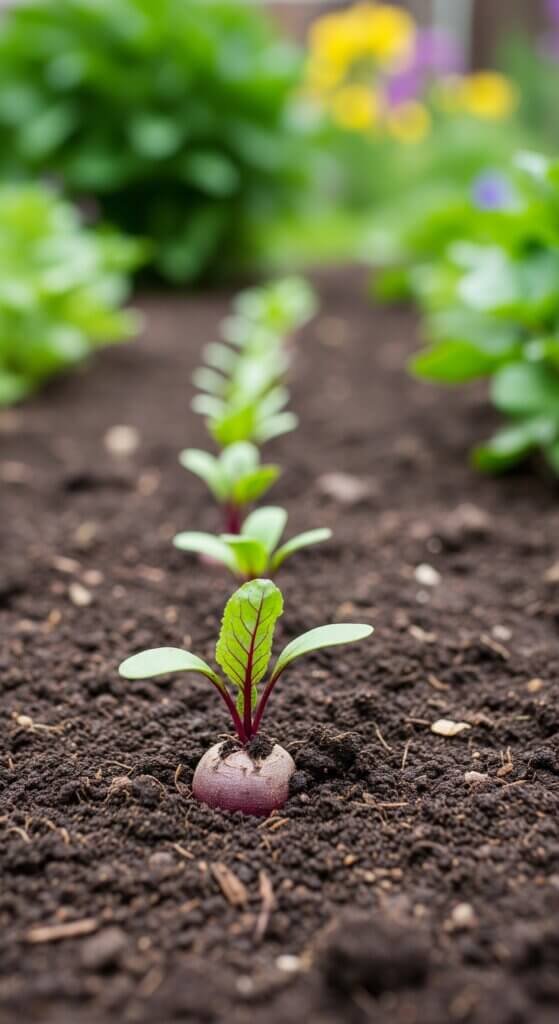
Germination and Early Care
beet seeds aren’t actually single seeds—they’re like little pods packed with 2–4 seeds inside.
So when you plant one and a mini crowd pops up, don’t freak out—it’s totally normal.
Germination requirements:
Germination takes 7–14 days, but only if conditions are just right.
What your seeds need to sprout:
- Soil temp: Between 50–85°F, but they’re happiest at 60–65°F (goldilocks zone).
- Consistent moisture: Keep it damp, not soggy—like a wrung-out sponge.
- Light: Once the seedlings break the surface, they need sunlight to grow strong.
- Stable temps: No wild swings. Beets don’t love surprise weather, and who can blame them?
Thinning process:
Once the seedlings are 2–3 inches tall, you’ll need to thin them out. Yep, time to say goodbye to the extras.
Here’s how to do it:
- Snip the extras with scissors—don’t yank! Pulling can mess with the roots of the ones you’re keeping.
- Leave about 1 strong seedling every 3–4 inches so they’ve got room to bulk up.
- Toss the thinned ones into a salad—they’re baby beet greens, and they’re delicious.
Early care essentials:
Baby beets are a little needy at first—but once they’re established, they’re pretty low-maintenance.
Your early care checklist:
- Keep the soil moist but not soggy. Dry spells = tough roots.
- Add a thin layer of mulch to hold moisture and cool the soil.
- Give some afternoon shade if it’s blazing hot out—they don’t like sunburn any more than we do.
- Watch for pests, especially flea beetles. Tiny holes in leaves? They’re probably the culprit.
Ongoing Care and Maintenance
Beets may be low-maintenance, but they’re not no-maintenance.
A little attention to water, nutrients, and timing goes a long way.
Think of it like keeping a houseplant alive… but tastier.
Watering Requirements:
Beets love steady moisture—too much one week and bone dry the next? That’s how you get cracked or tough roots.
Keep it consistent, and your beets will thank you by staying sweet and tender.
Watering tips:
- Water deeply, but not daily. Fewer, longer soakings help roots grow deep.
- Hit the soil, not the leaves. Wet foliage is an open invite to leaf disease.
- Use a soaker hose or drip line if you can—it’s set-it-and-forget-it hydration.
- Keep soil evenly moist during the main growing phase.
- Dial back watering right before harvest. Less water = better flavor and storage.
Fertilization schedule:
Beets are like that friend who eats clean but still wants the occasional snack.
They don’t need a ton of fertilizer—but a boost at the right time keeps them happy.
How to feed your beets:
- Before planting: Mix in compost or aged manure. It’s like prepping the pantry.
- Mid-season (when they’re 4–6 inches tall): Side-dress with a balanced 10-10-10 fertilizer or sprinkle some around the base.
- Going organic? Fish emulsion or kelp meal every 3–4 weeks works great—just don’t overdo it.
Skip high-nitrogen fertilizers during root growth. You’ll end up with monster leaves and sad little roots. It’s like training for a marathon but only doing arm day.
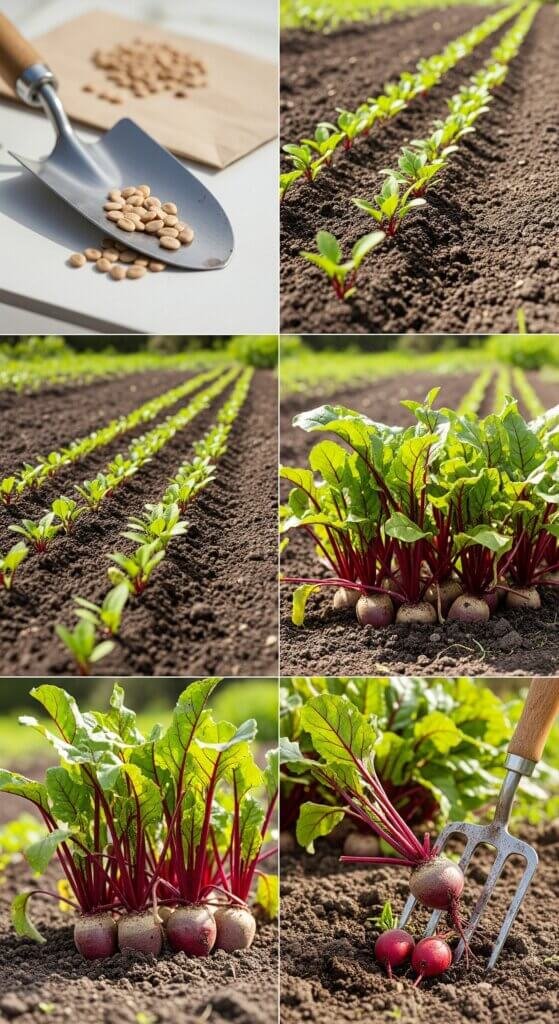
Common Problems and Solutions
Even the best-kept garden runs into trouble now and then. Beets aren’t high drama, but they’ll throw a fit if something’s off.
The good news? Most issues are easy to spot and fix—if you know what to look for.
Pest management:
- Flea beetles: Tiny jumpy bugs that leave polka-dot holes in the leaves.
Fix it: Use row covers, or invite beneficial nematodes to the party (they eat the larvae).
- Leaf Miners: They tunnel through leaves like they’re making subway maps.
Fix it: Snip off infested leaves before things spread.
- Aphids: They huddle under leaves like clingy exes.
Fix it: Spray with insecticidal soap or release ladybugs to eat them. Yes, ladybugs are savage.
- Cutworms: They’ll chop your seedlings at the base like it’s beetroot Game of Thrones.
Fix it: Use cardboard collars around young plants. It’s like medieval armor—but for seedlings.
Disease prevention:
- Cercospora leaf spot: Little circular spots that slowly take over the leaves.
Fix it: Give your plants space and airflow. Beets hate feeling crowded too.
- Damping-Off: Seedlings flop over and die out of nowhere.
Fix it: Don’t overwater and make sure your soil drains. Waterlogged = doom.
- Root Rot: Mushy roots from soggy soil.
Fix it: Improve drainage and chill on the watering. Beets aren’t into foot baths.
- Powdery Mildew: White dust on leaves like someone spilled flour.
Fix it: Give plants more elbow room and air circulation. Fungus hates fresh air.
Cultural problems:
- Bolting (flowering early): Usually from sudden weather swings.
Fix it: Use bolt-resistant varieties and don’t plant too early.
- Bad Germination: No-shows in your seed row?
Fix it: Use fresh seeds, prep the soil right, and keep it evenly moist.
- Woody Roots: Beets feeling tough and bitter?
Fix it: Water consistently and thin your seedlings. Crowding makes cranky roots.
- Tiny Beets: They tried their best but didn’t thrive.
Fix it: Give them space and loose, nutrient-rich soil from the start.
Harvesting Your Beetroot Crop
So your beets are finally looking like, well, beets—not just a bunch of leafy guesswork.
Now’s the moment of truth: harvesting.
Do it right, and you get sweet, tender roots that store like champs.
Do it wrong… and you risk cracking, bleeding, or bruising them. Let’s not go there.
Harvest indicators:
Most varieties are good to go in 55–70 days, but baby beets can be pulled earlier if you’re impatient (no judgment).
Look for these signs:
- The top of the root (a.k.a. the “shoulder”) is peeking above the soil.
- The root feels firm and about 1–3 inches wide (depending on the variety).
- Leaves are still green and healthy—if they’re yellowing or dying, you’ve waited a bit too long.
- Bonus tip: gently squeeze the root. If it’s soft or spongy, it’s over the hill.
Harvesting techniques:
- Water the soil first if it’s dry—moist soil makes pulling way easier.
- Loosen the soil with a garden fork or hand trowel. Don’t just yank.
- Gently lift the beets out like you’re handling fresh donuts—don’t bruise or break them.
- Snip the tops to about 1–2 inches of stem. Too close and they’ll “bleed” beet juice everywhere.
- Don’t wash them yet—just brush off the dirt and save the deep clean for when you’re ready to eat.
Storage methods:
Beets store like champs when you do it right. Here are your best options:
- Fridge: Store unwashed beets in perforated plastic bags. They’ll last 2–4 weeks easy.
- Root cellar (or DIY basement setup): Pack in slightly damp sand or peat moss. These babies can last 3–6 months like it’s no big deal.
- Freezing: Blanch, peel, chop, and freeze. Good for up to a year—perfect for soups and smoothies.
- Canning: Pressure-can them using a trusted recipe if you’re feeling hardcore and want long-term pantry power.
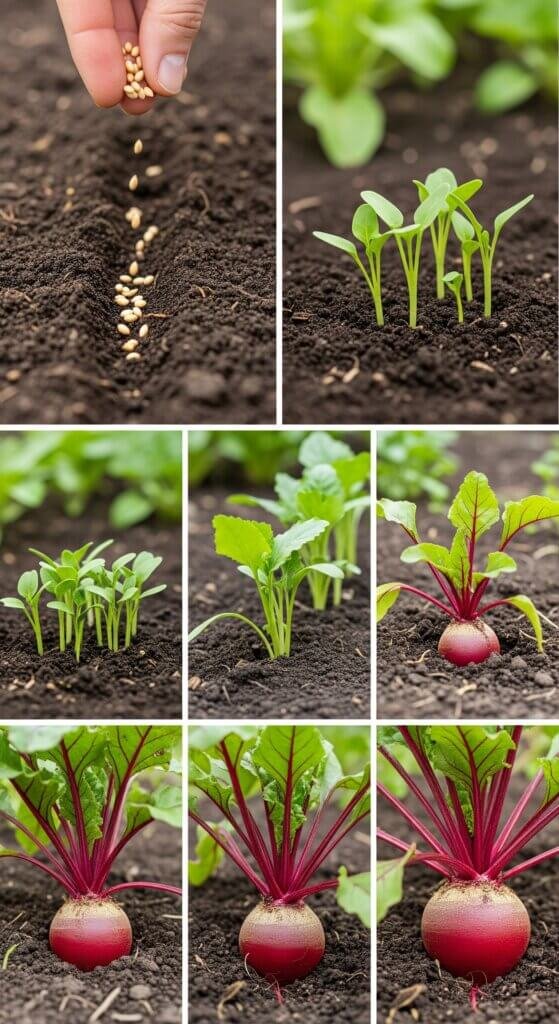
- Read also: Maximizing Germination: How to Plant Carrot Seeds Effectively
- Read also: A Beginner’s Guide: Tips for Growing Lettuce From Seed
Maximizing Your Beetroot Success
Once you’ve got the basics down, there are a few smart tricks to keep the beet train rolling all season long.
These little upgrades can boost your harvest, stretch your season, and keep your kitchen full without going full farm-mode.
Succession planting strategy
Instead of planting one big batch and ending up with 20 beets at once (hello, beet overload), spread it out.
Plant a new round every 2–3 weeks during the season.
That way, you’re always harvesting just enough—and you don’t have to turn your entire fridge into a beet bunker.
Companion planting benefits
Beets get along with most neighbors, but they really click with some:
Great companions:
- Lettuce – uses space while beets bulk up underneath
- Onions & garlic – help deter pests and don’t fight for space
- Brassicas (like cabbage or kale) – team players with different needs
Avoid:
- Pole beans – they’re kind of greedy and hog nutrients your beets need
Season extension techniques:
Want fresh beets beyond the “normal” season? You can totally cheat the calendar with a few clever tricks.
- Row covers: Protect against random frosts in spring or fall
- Cold frames: Perfect for overwintering in mild climates—like a cozy beet Airbnb
- Bolt-resistant varieties: For summer planting, these hold their cool when the heat hits
- Succession planting (again!): Because honestly, it works like magic
Final Thoughts: Beets Are Totally Worth It
Growing beets from seed is one of those low-effort, high-reward garden wins.
They’re tough, tasty, and give you double the harvest—sweet roots and nutritious greens.
Success comes down to picking the right variety, prepping your soil, staying consistent with care, and harvesting at the right time.
It’s not rocket science—just plant, pay attention, and learn as you go.
Start small, get the hang of it, and you’ll be pulling fresh beets all season like a pro.
Whether you’re new to gardening or just looking to shake up your crop list, beets are an easy yes.
Seriously, few things beat the feeling of harvesting food you grew from scratch. And beets? They’re reliable, tasty, and secretly pretty cool.

